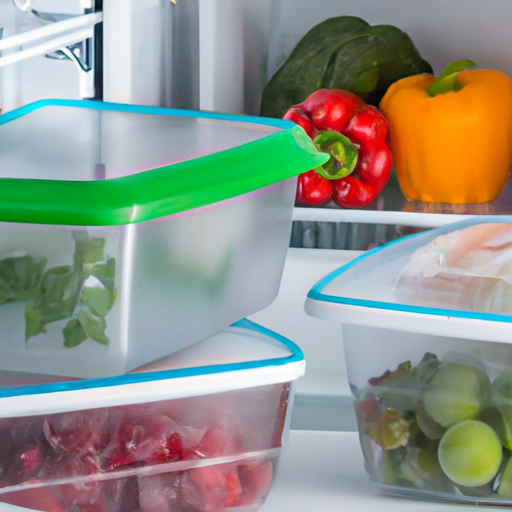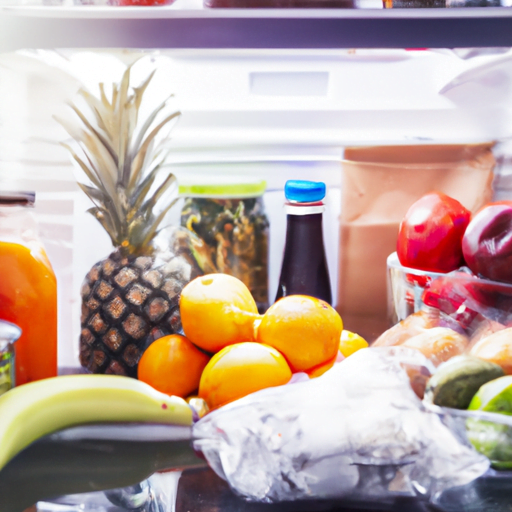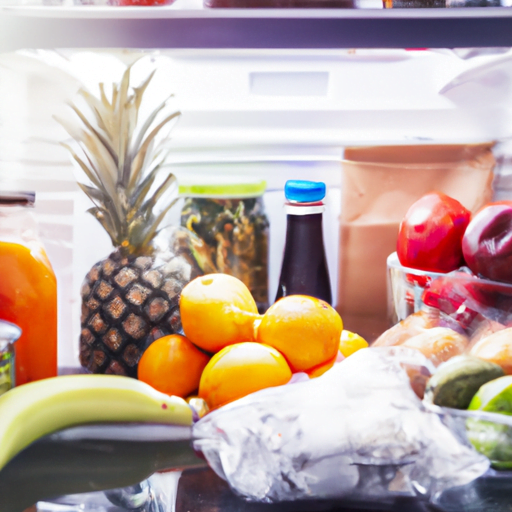Have you ever wondered what the best way to store your food in the freezer is? I mean, there’s nothing worse than finding a freezer burn on that steak you were so excited to cook, right? Well, I have some good news for you! In this article, I’m going to share with you some of the best freezer storage tips out there, so you can keep your food fresh and delicious for as long as possible.
Now, I know that freezer storage might not be the most exciting topic out there, but trust me, it’s important. Properly storing your food in the freezer can make a huge difference in its taste and quality. From organizing your freezer to choosing the right containers, there are plenty of little tricks and techniques that can help prolong the shelf life of your frozen goods.
So, whether you’re someone who likes to meal prep and freeze meals for later, or if you just prefer buying food in bulk and freezing it, this article is for you. We’ll explore the best containers for freezer storage, the do’s and don’ts of freezing different types of food, and even some tips on how to prevent freezer burn. Trust me, by the end of this article, you’ll be a freezer storage pro. So, let’s dive in and learn some freezer storage tricks that’ll save you time, money, and the disappointment of freezer-burnt food.

Best Freezer Storage Tips
Living off-grid often means relying on alternative methods for preserving food, and one of the most effective and convenient options is a freezer. However, to make the most of your freezer storage and avoid food waste, it’s important to follow proper organization and storage techniques. In this article, we will discuss the best freezer storage tips, including how to sort and categorize your food items, use appropriate packaging materials, and maintain optimal freezing conditions. By implementing these tips, you can prolong the shelf life of your food, save money, and reduce food waste.
Proper Freezer Organization
The first step to efficient freezer storage is to sort and categorize your food items. This not only makes it easier to locate specific items but also helps prevent cross-contamination and spoilage. Consider grouping similar food items together, such as meats, baked goods, fruits and vegetables, dairy products, and sauces and soups. This way, you can quickly identify what you need without rummaging through a disorganized freezer.
To further enhance organization, use clear containers or bags for storing your food. Transparent containers allow you to easily see the contents without having to open them. You can use plastic or glass containers, as long as they are freezer-safe. Similarly, using clear freezer bags allows you to quickly identify the food inside and easily stack them.
Labeling everything is crucial when it comes to freezer storage. Include the name of the food, as well as the date it was frozen. This way, you can keep track of how long each item has been in the freezer and avoid consuming expired food. Use waterproof and smear-proof labels to ensure that the information stays intact even in a frozen environment.
If you have the space and budget, consider investing in a chest freezer. Chest freezers offer more storage capacity compared to upright freezers, allowing you to store a larger variety and quantity of food. They also tend to be more energy efficient, which can be beneficial when living off-grid. However, if a chest freezer is not feasible, you can still optimize your freezer storage by using shelves, compartments, and organizers efficiently.
Freezing Techniques
Properly wrapping food before freezing is essential to prevent freezer burn and maintain the quality of the food. Freezer burn occurs when moisture in the food evaporates and crystallizes, causing dry and discolored patches. To avoid this, wrap the food tightly in freezer-safe packaging materials, such as plastic wrap, aluminum foil, or freezer bags. Ensure there are no air pockets that could lead to freezer burn.
When it comes to freezing fruits and vegetables, pre-freezing them can help preserve their quality. Wash, peel, and chop the produce before placing them on a baking sheet lined with parchment paper. Make sure the pieces are not touching each other and freeze them for a couple of hours. Once frozen, transfer the pre-frozen fruits or vegetables into freezer bags or containers. This method prevents them from sticking together and allows for easier portioning when you need to take out a small quantity.
It’s important to avoid freezing large quantities of food at once, as this can overwhelm the freezer and impact the freezing efficiency. Instead, freeze smaller portions, especially for items that you may not use frequently. Using ice trays or silicone molds can be helpful in this regard, as they allow you to freeze food in individual portions. This is particularly useful for items like herbs, sauces, broth, or even baby food.
Foods That Freeze Well
Certain foods freeze exceptionally well and can be stored for extended periods without significant loss in quality. Here are some examples:
- Meats: Chicken, beef, pork, and fish can all be safely frozen. However, it’s important to properly wrap them to prevent freezer burn and maintain their flavor and texture.
- Baked goods: Bread, cookies, and pastries can be frozen to extend their shelf life. Be sure to wrap them tightly to prevent them from drying out.
- Fruits and vegetables: Berries, peas, corn, and broccoli freeze well and retain their nutritional value when properly stored.
- Dairy products: Cheese, milk, and butter can all be safely frozen, although the texture may change slightly. It’s best to label them with the freeze date to keep track of freshness.
- Sauces and soups: Tomato sauce, chili, and broth can all be frozen in portions for easy meal preparation later on.
Foods That Don’t Freeze Well
While many foods freeze beautifully, there are some that don’t fare as well in the freezer. Here are a few examples:
- Soft fruits like strawberries and melons tend to become mushy and lose their texture when frozen. It’s better to enjoy these fruits fresh or canned.
- Cream-based sauces and soups can separate or become grainy when frozen. If you want to preserve these types of dishes, consider freezing them without the dairy ingredients and add them when reheating.
- Eggs in their shell should not be frozen because the liquid expands when frozen, causing the shell to crack and introducing the risk of bacterial contamination.
- Lettuce and other leafy greens tend to become limp and watery when frozen. They are best enjoyed fresh or cooked before freezing.
- Cooked pasta and rice can become mushy when frozen. If you plan to use them in a dish that requires cooking, it’s best to freeze the sauce or other components separately and add the cooked pasta or rice later on.
Freezer Maintenance
Regularly defrosting and cleaning your freezer is crucial for maintaining optimal freezing conditions and preventing the buildup of ice. Ice buildup can reduce the efficiency of the freezer and lead to uneven temperature distribution. Set a regular schedule for defrosting and cleaning, and make sure to remove all food items before starting the process.
Checking the temperature of your freezer is another essential maintenance task. The ideal freezer temperature should be around 0°F (-18°C) to keep food frozen and safe to consume. Use a freezer thermometer to monitor the temperature regularly and adjust as needed. Avoid frequent temperature fluctuations by minimizing the time the freezer door is open and ensuring a proper seal.
Speaking of seals, regularly check for any malfunctioning seals or doors on your freezer. Damaged seals can allow warm air to enter the freezer, causing temperature fluctuations and potential food spoilage. If you notice any issues with the seals, consider replacing them promptly.
Organizing and rotating your frozen food inventory is key to ensuring that nothing gets forgotten or goes to waste. Use the first-in, first-out rule to consume older items before newer ones. This helps to maintain freshness and prevent forgotten food from becoming freezer-burned.
Keeping a freezer inventory list can be extremely helpful in staying organized and avoiding food waste. Note down the items you have in the freezer, along with their freeze dates. This way, you can easily plan meals, know what needs to be used soon, and avoid buying duplicate items.
Safe Thawing Methods
When it comes to thawing frozen food, it’s important to choose safe methods to prevent bacterial growth. Here are a few options:
- Thawing in the refrigerator is the safest method, as it allows for slow and controlled thawing. Simply transfer the frozen food from the freezer to the refrigerator and let it thaw gradually. This method works best for larger items like whole chickens or roasts.
- Thawing using cold water is a quicker method, but it requires constant supervision. Place the frozen food in a leak-proof bag and submerge it in cold water. Change the water every 30 minutes to maintain the cold temperature. Make sure to cook the food immediately after thawing.
- Thawing in the microwave is suitable for small items that will be cooked immediately after thawing. Use the defrost setting on the microwave and follow the manufacturer’s instructions to prevent uneven cooking or partial thawing.
- Thawing directly in the cooking process is an option for certain foods, such as ground meat or frozen vegetables. You can add the frozen ingredients to soups, stews, or stir-fries, allowing them to thaw and cook simultaneously.
Maximizing Freezer Space
When living off-grid, optimizing freezer space becomes essential. Here are a few tips for maximizing your freezer storage:
- Use freezer shelves and compartments efficiently. Arrange the food items in a way that maximizes the use of available space, with frequent use items easily accessible in the front.
- Stack food items vertically to create more space. Ensure stability by using sturdy containers or bags and be mindful of the weight distribution.
- Invest in space-saving organizers, such as bins, baskets, or dividers, to keep the freezer neat and maximize storage capacity. These organizers can help separate different food categories or make it easier to locate specific items.
- Consider vacuum sealing food for compact storage. Vacuum-sealed bags remove excess air and help prevent freezer burn. This method is particularly useful for items that need to be stored for a long time, such as meat or bulk purchases.
- Store food in flat, stackable containers whenever possible. This not only saves space but also allows for easy stacking and organization.
Freezer Storage Do’s and Don’ts
To ensure optimal freezer storage, here are a few do’s and don’ts to keep in mind:
- Do freeze food at its freshest. Freezing food at its peak quality ensures better taste and texture when thawed.
- Do date and label everything. This helps you keep track of freshness and prevents consuming expired food.
- Do use proper packaging materials. Invest in freezer-safe containers, bags, and wraps to maintain quality and prevent freezer burn.
- Don’t overload the freezer. Overcrowding the freezer can impede air circulation and affect the freezing efficiency.
- Don’t refreeze thawed food. Once food has been thawed, it should be cooked and consumed promptly. Refreezing can lead to bacterial contamination and affect the quality.
Tips for Freezer Storage Longevity
To ensure that your freezer storage remains long-lasting, consider these additional tips:
- Maintain a consistent temperature by minimizing temperature fluctuations. Avoid leaving the freezer door open for extended periods and ensure a proper seal.
- Keep the freezer well-stocked. A full freezer retains cold more efficiently than a partially empty one. If your freezer is not filled to capacity, consider using ice packs or containers filled with water to occupy the extra space.
- Use the first-in, first-out rule when consuming frozen items. This helps ensure that older items are used before newer ones, minimizing the chances of freezer burn or food waste.
- Regularly check for food spoilage by inspecting the quality and smell of the items in your freezer. Discard any food that appears to be freezer-burned, has changed color, or has an unpleasant odor.

Conclusion
By following these best freezer storage tips, you can effectively preserve a wide variety of foods while living off-grid. From proper organization and packaging to maintaining optimal freezing conditions, these techniques will help prolong the shelf life of your food, save you money, and reduce food waste. Whether you’re relying on a traditional freezer or considering investing in a chest freezer, by implementing these tips, you can make freezer storage an efficient tool for preserving your favorite foods.




